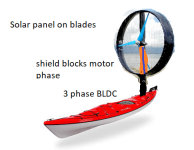parajared
10 kW
Would it be a bad idea to run raw solar amperage direct from panel to a brushed motor; no esc, no solar charge controller, no battery?
I've gotten into multi-day kayak touring and I have a decently efficient boat but the possibly hairbrained notion of a solar panel assisting with overall effort has taken it's hold. I imagine a fixed-position motor mounted to the existing rudder mount while I provide the steering and the rest of the momentum with a paddle. There would be no power levels, no steering the motor, no battery storage, just a simple on/off relay that cuts motor power when I don't want it.
Here's what I'm worried about:
1) It seems like there might need to be some kind of circuitry other than an on/off relay needed between panel and motor, would something overload?
2) the panel voltage I currently have is "12 volts" and the trolling motor I am considering is also "12 volts" but since my solar panel reads 18 volts in direct sun and I'm not sure if the "12 volt" motor could handle that. I'm looking at an old 8lb thrust Minn Kota on Craigslist but haven't bought it.
I've gotten into multi-day kayak touring and I have a decently efficient boat but the possibly hairbrained notion of a solar panel assisting with overall effort has taken it's hold. I imagine a fixed-position motor mounted to the existing rudder mount while I provide the steering and the rest of the momentum with a paddle. There would be no power levels, no steering the motor, no battery storage, just a simple on/off relay that cuts motor power when I don't want it.
Here's what I'm worried about:
1) It seems like there might need to be some kind of circuitry other than an on/off relay needed between panel and motor, would something overload?
2) the panel voltage I currently have is "12 volts" and the trolling motor I am considering is also "12 volts" but since my solar panel reads 18 volts in direct sun and I'm not sure if the "12 volt" motor could handle that. I'm looking at an old 8lb thrust Minn Kota on Craigslist but haven't bought it.


